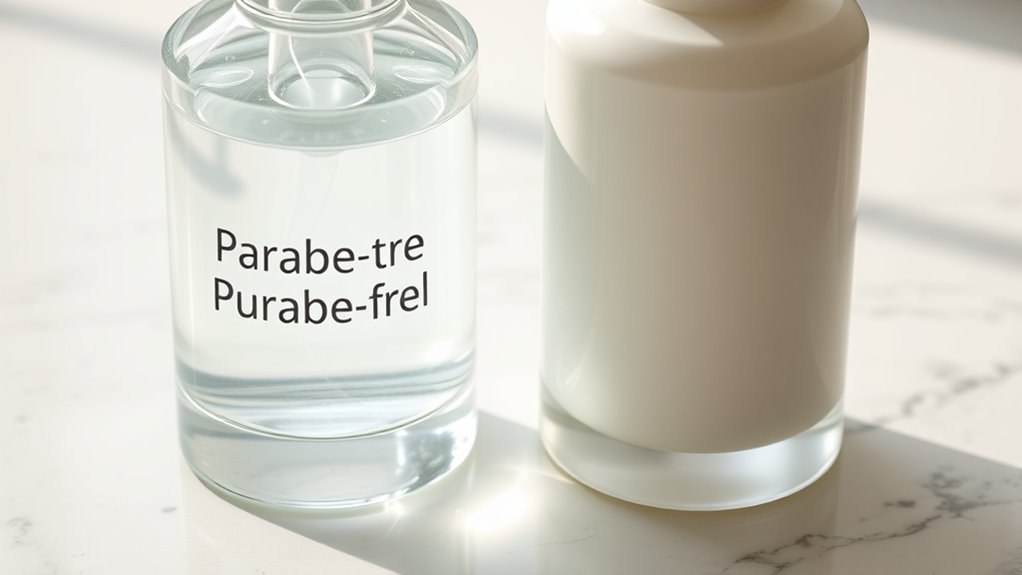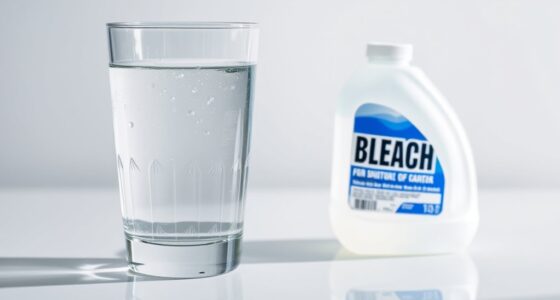Choosing “paraben-free” products doesn’t automatically make them safer, as the alternative preservatives like phenoxyethanol or formaldehyde-releasers can also pose health risks. Regulations set safety limits, but they don’t guarantee total safety, especially with long-term or sensitive use. Ultimately, the safety depends on the product’s overall formulation and your individual sensitivities. To understand the full picture and make informed choices, it’s helpful to explore what’s behind “paraben-free” labels.
Key Takeaways
- “Paraben-free” labels do not automatically mean the product is free from all potential risks or safer overall.
- Alternatives used in “paraben-free” products, like phenoxyethanol, may have their own safety concerns.
- Regulatory standards limit ingredient concentrations but do not guarantee complete safety or eliminate health risks.
- The safety of preservatives depends on formulation, individual sensitivities, and long-term exposure, not just the presence of parabens.
- Informed choices require understanding ingredient safety, product formulations, and choosing reputable brands beyond just “paraben-free” labels.

Are paraben-free products truly safer for your health? This question has become increasingly common as more brands advertise their items as free from parabens, a group of preservatives used to extend shelf life and prevent bacterial growth. While avoiding parabens might seem like a smart move, it’s essential to contemplate what’s behind these claims. The safety of any cosmetic ingredient depends heavily on chemical safety and how products align with regulatory standards. Manufacturers are supposed to follow strict guidelines set by health authorities, ensuring that ingredients are safe for consumer use. However, the reality is more complicated, and just because a product is labeled “paraben-free” doesn’t automatically mean it’s risk-free.
Chemical safety plays a vital role in determining whether a product is genuinely safe for your skin and overall health. Parabens, such as methylparaben and propylparaben, have been scrutinized because they can mimic estrogen, a hormone involved in many bodily functions. Some studies suggest that parabens may interfere with hormonal balance, potentially contributing to health issues over long-term exposure. That’s why many consumers choose to avoid them. But it’s equally important to understand what replaces parabens in “paraben-free” products. Sometimes, these alternatives—like phenoxyethanol or formaldehyde-releasing agents—are less well-studied, and their safety profiles aren’t always clear. This switch raises questions about whether the alternatives are truly safer, or if they carry their own risks.
Regulatory standards are designed to protect consumers by setting limits on ingredient concentrations and requiring safety testing. Agencies like the U.S. Food and Drug Administration (FDA) and the European Medicines Agency (EMA) establish guidelines to ensure products are safe when used as directed. Still, these standards are not infallible. Regulations often lag behind emerging scientific research, and some ingredients may be deemed safe at certain levels but could pose health concerns if used excessively or in sensitive populations. When you see “paraben-free” labels, it’s tempting to assume that these products meet higher safety standards. But in reality, they must still comply with existing regulations, which might not fully account for cumulative or long-term exposure effects.
Ultimately, the safest choice depends on informed decision-making. Just because a product is labeled “paraben-free” doesn’t guarantee it’s completely risk-free. You need to understand the broader context of chemical safety and regulatory standards, and consider the overall formulation. Look beyond labels, research ingredients, and choose products from reputable brands that prioritize transparency and safety testing. This way, you can make better choices for your health while steering through the complex landscape of cosmetic ingredients.
Frequently Asked Questions
Do Parabens Cause Hormonal Disruptions?
Parabens can cause hormonal disruptions by mimicking estrogen, which may impact your endocrine system. While research shows they have a hormonal impact, the extent of this disruption varies and isn’t fully conclusive. If you’re concerned about endocrine disruption, choosing paraben-free products might reduce potential risks. Always check ingredient labels and opt for formulations that support your health and well-being.
Are “Paraben-Free” Labels Always Reliable?
You can’t always rely on “paraben-free” labels, as regulatory standards for marketing strategies vary. Some brands may use the label to appeal to health-conscious consumers without strict oversight, so it’s wise to read ingredient lists carefully. Always research brands and check for third-party testing to guarantee product safety. Don’t assume a label guarantees a product is free from potentially harmful ingredients—do your own due diligence.
Can Parabens Trigger Allergic Reactions?
Parabens can trigger allergic reactions and skin irritation in some people, especially those with fragrance allergies. If you have sensitive skin or known allergies, you might experience redness, itching, or swelling after using products containing parabens. While not everyone reacts, it’s wise to check labels carefully. Choosing paraben-free products can reduce the risk of allergic responses and skin irritation, especially if you’re prone to fragrance allergies.
Do All Natural Ingredients Avoid Parabens?
Not all natural ingredients avoid parabens, as some natural preservatives may still contain them, though it’s rare. Many products use synthetic compounds as preservatives instead of parabens, but these aren’t necessarily safer either. You should check ingredient lists carefully, because natural preservatives like essential oils or plant extracts can be effective, but not all natural ingredients are free from parabens or synthetic compounds. Always read labels to make informed choices.
Are There Safer Alternatives to Parabens?
Yes, there are safer alternatives to parabens. You can look for products with natural preservatives like vitamin E, rosemary extract, or neem oil, which help extend shelf life without synthetic chemicals. These options are generally gentler on your skin and the environment. Always check product labels to verify they use natural preservatives, and avoid harsh synthetic chemicals that may cause irritation or long-term health concerns.
Conclusion
Ultimately, choosing paraben-free products is like steering clear of stormy seas—safer and calmer for your skin’s voyage. While they might not be foolproof, these products often reduce exposure to potential irritants and hormone disruptors. Think of it as swapping a risky game for a safer dance—giving you peace of mind and a healthier glow. So, trust your instincts and navigate your beauty routine with confidence, knowing you’re steering toward safer, kinder choices.








